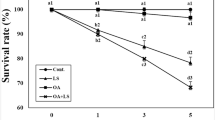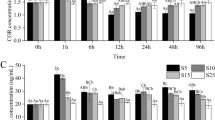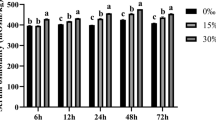Abstract
Salinity is one of the critical ecological factors which will impact the growth and development of marine shellfish. With the rapid expansion of aquaculture area for Haliotis discus hannai, the frequent summer rainstorms in South China, the influx of freshwater, or the strong volatility of seawater in coastal areas, inner bays have placed abalone into the dynamic environment where the salinity is changing drastically. This work examined the effects of sudden salinity changes on abalone’s survival, osmotic pressure regulation, energy metabolism, and related gene expression by simulating the salinity changes of water for breeding H. discus hannai caused by heavy storm. The salinity was gradually reduced from 30 to 20, then kept at 20 for 48 h, followed by gradual increase to 30, and was kept at 30 for 48 h. Samples were taken at 6, 12, 36, 60, 66, 72, 96, and 120 h after the start of the experiment, respectively. Results showed that the survival rate of abalone at 120 h was significantly lower than that at any other time except at 96 h (P < 0.05). With the decrease and increase of salinity, the hemolymph osmotic pressure and the concentration of Na+, K+, Ca2+, Cl− in the hemolymph also followed the same trend, while the concentration of hemocyanin, total soluble protein, taurine, and free amino acids showed an inverse trend. The activity of Na+/K+-ATPase also increased then declined with salinity changes. Except at 0, 6, and 12 h, the activity of Na+/K+-ATPase in the salinity-changing group was significantly higher than that in the control group (P < 0.05). In the salinity-changing group, the activity of pyruvate kinase, succinate dehydrogenase, and malate dehydrogenase reached a maximum at 72 h, but no significant difference was found at the end of the experiment compared to the control group (P > 0.05). The expression levels of catalase, thioredoxin peroxidase, sigma-glutathione-s-transferase, and Mu-glutathione-s-transferase significantly rose with the salinity changes, and were significantly higher than that in the control group up to the end of the experiment (P < 0.05). As sudden salinity changes may cause some abalone deaths, the enhanced activity of related enzymes and the increase of gene expression levels might be one of the effective methods for an organism to respond to salinity stress and regulate osmotic pressure.






Similar content being viewed by others
References
Almroth, B. C., N. Asker, B. Wassmur, M. Rosengren, F. Jutfelt, A. Gräns, K. Sundell, M. Axelsson & J. Sturve, 2015. Warmer water temperature results in oxidative damage in an Antarctic fish, the bald notothen. Journal of Experimental Marine Biology and Ecology 468: 130–137.
Amende, L. M. & S. K. Pierce, 1980. Cellular-volume regulation in salinity stressed mollusks: the response of Noetia ponderosa (Arcidae) red blood cells to osmotic variation. Comparative Biochemistry and Physiology – Part B 138: 283–289.
Ballantyne, J. S. & C. D. Moyes, 1987. Osmotic effects on fatty acid, pyruvate, and ketone-body oxidation in oyster gill mitochondria. Physiological Zoology 60: 713–721.
Berger, V. J. & A. D. Kharazova, 1997. Mechanisms of salinity adaptations in marine molluscs. Hydrobiologia 355: 115–126.
Bradford, M., 1976. A rapid and sensitive method for the quantitation of microgram quantities of protein utilizing the principle of protein-dye binding. Analytical Biochemistry 72: 248–254.
Burke, C. M., J. O. Harris, S. M. Hindrum, S. J. Edwards & G. B. Maguire, 2001. Environmental Requirements of Abalone. University of Tasmania, Tasmania, Australia, School of Aquaculture: 90–97.
Castagna, M. & P. Chanley, 1973. Salinity tolerance of some marine bivalves from inshore and estuarine environments in Virginia waters on the western mid-Atlantic coast. Malacologia 12: 47–96.
Charmantier, G., M. Charmantier-Daures & K. Anger, 1998. Ontogeny of osmoregulation in the grapsid crab Armases miersii (Crustacea, Decapoda). Marine Ecology Progress Series 164: 285–292.
Chen, J. & W. Chen, 2000. Salinity tolerance of Haliotis diversicolor supertexta at different salinity and temperature levels. Aquaculture 181: 191–203.
Chen, J. C. & C. Y. Lin, 1995. Responses of oxygen consumption, ammonia-N excretion and urea-N excretion of Penaeus chinensis exposed to ambient ammonia at different salinity and pH levels. Aquaculture 136: 243–255.
Cheng, W., S. P. Yeh, C. S. Wang & J. C. Chen, 2002. Osmotic and ionic changes in Taiwan abalone Haliotis diversicolor supertexta at different salinity levels. Aquaculture 203: 349–357.
Cheng, W., F. M. Juang & J. C. Chen, 2004. The immune response of Taiwan abalone Haliotis diversicolor supertexta and its susceptibility to Vibrio parahaemolyticus at different salinity levels. Fish & Shellfish Immunology 16: 295–306.
Cooper, A. R. & S. Morris, 1997. Osmotic and ionic regulation by Leptograpsus variegatus during hyposaline exposure and in response to emersion. Journal of Experimental Marine Biology and Ecology 214: 263–282.
Corotto, F. S. & C. W. Holliday, 1996. Branchial Na+/K+-ATPase and osmoregulation in the purple shore crab, Hemigrapsus nudus (Dana). Comparative Biochemistry and Physiology – Part A 113: 361–368.
Dall, W. & D. M. Smith, 1986. Oxygen consumption and ammonia-N excretion in fed and starved tiger prawns, Penaeus esculentus Haswell. Aquaculture 55: 23–33.
Deaton, L. E., 1992. Osmoregulation and epithelial permeability in two euryhaline bivalve mollusks: Mya arenaria and Geukensia demissa. Journal of Experimental Marine Biology and Ecology 158: 167–177.
Edwards, S., 2003. Assessment of the physiological effect of altered salinity on greenlip (Haliotis laevigata) and blacklip (Haliotis rubra) abalone using respirometry. Aquaculture Research 34: 1361–1365.
Ekanayake, P. M., M. De Zoysa, H. S. Kang, W. Qiang, Y. Jee, Y. H. Lee, S. J. Kim & J. Lee, 2008. Cloning, characterization and tissue expression of disk abalone (Haliotis discus discus) Catalase. Fish & Shellfish Immunology 24: 267–278.
Ferro, D., N. Franchi, V. Mangano, R. Bakiu, M. Cammarata, N. Parrinello, G. Santovito & L. Ballarin, 2013. Characterization and metal-induced gene transcription of two new copper zinc superoxide dismutases in the solitary ascidian Ciona intestinalis. Aquatic Toxicology 140–141: 369–379.
Ferro, D., R. Bakiu, C. De Pittà, F. Boldrin, F. Cattalini, S. Pucciarelli, C. Miceli & G. Santovito, 2015. Cu, Zn superoxide dismutases from Tetrahymena thermophila: molecular evolution and gene expression of the first line of antioxidant defenses. Protist 166: 131–145.
Fisher, W. S. & R. I. E. Newell, 1986. Salinity effects on the activity of granular hemocytes of American oysters, Crassostrea virginica. The Biological Bulletin 170: 122–134.
Fokina, N. N., Z. A. Nefedova, N. N. Nemova & V. V. Khalaman, 2007. Modulating role of lipids and their fatty acids in adaptation of the White Sea mussels Mytilus edulis L. to environmental salinity change. Journal of Evolutionary Biochemistry and Physiology 43: 379–387.
Gao, X. L., M. Zhang, X. Li, C. Shi, C. B. Song & Y. Liu, 2016a. Effects of LED light quality on the growth, metabolism, and energy budgets of Haliotis discus discus. Aquaculture 453: 31–39.
Gao, X. L., M. Zhang, H. Q. Tian, J. M. Zheng, X. Li, C. B. Song & Y. Liu, 2016b. Effect of LED light quality on respiratory metabolism and activities of related enzymes of Haliotis discus hannai. Aquaculture 452: 52–61.
Garçon, D. P., D. C. Masui, F. L. M. Mantelatto, R. P. M. Furriel, J. C. McNamara & F. A. Leone, 2009. Hemolymph ionic regulation and adjustments in gill (Na+, K+)-ATPase activity during salinity acclimation in the swimming crab Callinectes ornatus (Decapoda, Brachyura). Comparative Biochemistry and Physiology – Part A 154: 44–55.
Gilles, R., 1977. Effects of osmotic stresses on the proteins concentration and pattern of Eriocheir sinensis blood. Comparative Biochemistry and Physiology – Part A 56: 109–114.
Gosling, E., 2003. Bivalve Molluscs: Biology, Ecology and Culture. Blackwell, Oxford: 201–224.
Handeland, S. O. & S. O. Stefansson, 2002. Effects of salinity acclimation on pre-smolt growth, smolting and post-smolt performance in off-season Atlantic salmon smolts (Salmo salar L.). Aquaculture 209: 125–137.
He, X. G., P. Zhuang, L. Z. Zhang & C. X. Xie, 2009. Osmoregulation in juvenile Chinese sturgeon (Acipenser sinensis Gray) during brackish water adaptation. Fish Physiology and Biochemistry 35: 223–230.
Hildreth, J. E. & W. B. Stickle, 1980. The effects of temperature and salinity on the osmotic composition of the southern oyster drill, Thais haemastoma. The Biological Bulletin 159: 148–161.
Hosoi, M., S. Kubota, M. Toyohara, H. Toyohara & I. Hayashi, 2003. Effect of salinity change on free amino acid content in Pacific oyster. Fisheries Science 69: 395–400.
Hu, M. H., F. L. Wu, M. Z. Yuan, Q. Z. Li, Y. D. Gu, Y. J. Wang & Q. G. Liu, 2015. Antioxidant responses of triangle sail mussel Hyriopsis cumingii exposed to harmful algae Microcystis aeruginosa and hypoxia. Chemosphere 139: 541–549.
Huong, D. T. T., W. J. Yang, A. Okuno & M. N. Wilder, 2001. Changes in free amino acids in the hemolymph of giant freshwater prawn Macrobrachium rosenbergii exposed to varying salinities: relationships to osmoregulatory ability. Comparative Biochemistry and Physiology – Part A 128: 317–326.
Huong, D. T. T., S. Jasmani, V. Jayasankar & M. Wilder, 2010. Na/K-ATPase activity and osmo-ionic regulation in adult whiteleg shrimp Litopenaeus vannamei exposed to low salinities. Aquaculture 304: 88–94.
Kang, C. K., S. C. Tsai, T. H. Lee & P. P. Hwang, 2008. Differential expression of branchial Na+/K+-ATPase of two medaka species, Oryzias latipes and Oryzias dancena, with different salinity tolerances acclimated to fresh water, brackish water and seawater. Comparative Biochemistry and Physiology – Part A 151: 566–575.
Kaplan, J. H., 2005. Biochemistry of Na+, K+-ATPase. Annual Review of Biochemistry 71: 511–535.
Kim, W. S., J. M. Kim, M. S. Kim, C. W. Park & H. T. Huh, 1998. Effects of sudden changes in salinity on endogenous rhythms of the spotted sea bass Lateolabrax sp. Marine Biology 131: 219–225.
Laiz-Carrión, R., S. Sangiao-Alvarellos, J. M. Guzmán, M. P. Martín del Río, J. M. Míguez, J. L. Soengas & J. M. Mancera, 2002. Energy metabolism in fish tissues related to osmoregulation and cortisol action. Fish Physiology and Biochemistry 27: 179–188.
Li, Y. H., L. Wei, J. R. Cao, L. G. Qiu, X. Jiang, P. Li, Q. Q. Song, H. L. Zhou, Q. Han & X. P. Diao, 2016. Oxidative stress, DNA damage and antioxidant enzyme activities in the Pacific white shrimp (Litopenaeus vannamei) when exposed to hypoxia and reoxygenation. Chemosphere 144: 234–240.
Lucu, Č. & M. Devescovi, 1999. Osmoregulation and branchial Na+, K+-ATPase in the lobster Homarus gammarus acclimated to dilute seawater. Journal of Experimental Marine Biology and Ecology 234: 291–304.
Marqueze, A., L. C. Kucharski & R. S. M. Da Silva, 2006. Effects of anoxia and post-anoxia recovery on carbohydrate metabolism in the jaw muscle of the crab Chasmagnathus granulatus maintained on carbohydrate-rich or high-protein diets. Journal of Experimental Marine Biology and Ecology 332: 198–205.
Martello, L. B., C. S. Friedman & R. S. Tjeerdema, 2000. Combined effects of pentachlorophenol and salinity stress on phagocytic and chemotactic function in two species of abalone. Aquatic Toxicology 49: 213–225.
Masui, D. C., F. L. M. Mantelatto, J. C. McNamara, R. P. M. Furriel & F. A. Leone, 2009. Na+, K+-ATPase activity in gill microsomes from the blue crab, Callinectes danae, acclimated to low salinity: novel perspectives on ammonia excretion. Comparative Biochemistry and Physiology – Part A 153: 141–148.
Mat, C. R. B. C. & W. T. W. Potts, 1985. Intracellular osmotic regulation in Crangon vulgaris. Comparative Biochemistry and Physiology – Part A 82: 719–724.
Metón, I., F. Fernández & I. V. Baanante, 2003. Short- and long-term effects of refeeding on key enzyme activities in glycolysis–gluconeogenesis in the liver of gilthead seabream (Sparus aurata). Aquaculture 225: 99–107.
Morris, S., 2001. Neuroendocrine regulation of osmoregulation and the evolution of air-breathing in decapod crustaceans. Journal of Experimental Biology 204: 979–989.
Natochin, Yu. V., V. Ya. Berger, V. V. Khlebovich, E. A. Lavrova & O. Yu. Michailova, 1979. The participation of electrolytes in adaptation mechanisms of intertidal mollusk’s cells to altered salinity. Comparative Biochemistry and Physiology – Part A 63: 115–119.
Navarro, J. M., 1988. The effects of salinity on the physiological ecology of Choromytilus chorus (Molina, 1782) (Bivalvia: Mytilidae). Journal of Experimental Marine Biology and Ecology 122: 19–33.
Nickerson, K. W. & K. E. Van Holde, 1971. A comparison of molluscan and arthropod hemocyanin – I. Circular dichroism and absorption spectra. Comparative Biochemistry and Physiology – Part B 39: 855–872.
Paul, R. J. & R. Pirow, 1998. The physiological significance of respiratory proteins in invertebrates. Zoology 100: 298–306.
Pequeux, A., 1995. Osmotic regulation in crustaceans. Journal of Crustacean Biology 15: 1–60.
Peterson, G. L., 1978. A simplified method for analysis of inorganic phosphate in the presence of interfering substances. Analytical Biochemistry 84: 164–172.
Rodriguez, G. A., 1981. Osmoregulation and total serum protein of two species of penaeidean shrimps from the Pacific coast of Mexico. Journal of Crustacean Biology 1: 392–400.
Rosas, C., G. Cuzon, G. Gaxiola, C. Pascual, G. Taboada, L. Arena & A. van Wormhoudt, 2002. An energetic and conceptual model of the physiological role of dietary carbohydrates and salinity on Litopenaeus vannamei juveniles. Journal of Experimental Marine Biology and Ecology 268: 47–67.
Tolomeo, A. M., A. Carraro, R. Bakiu, S. Toppo, S. P. Place, D. Ferro & G. Santovito, 2016. Peroxiredoxin 6 from the Antarctic emerald rockcod: molecular characterization of its response to warming. Journal of Comparative Physiology B 186: 59–71.
Towle, D. W., 1981. Role of Na+ + K+-ATPase in ionic regulation by marine and estuarine animals. Marine Biology Letters 2: 107–122.
Wan, Q., I. Whang & J. Lee, 2008. Molecular characterization of mu class glutathione-s-transferase from disk abalone (Haliotis discus discus), a potential biomarker of endocrine-disrupting chemicals. Comparative Biochemistry and Physiology – Part B 150: 187–199.
Wickramaarachchilage, A. P., M. De Zoysa, H. S. Kang, C. Oh, I. Whang, S. J. Kim & J. Lee, 2008. Comparative study of two thioredoxin peroxidases from disk abalone (Haliotis discus discus): cloning, recombinant protein purification, characterization of antioxidant activities and expression analysis. Fish & Shellfish Immunology 24: 294–307.
Zaugg, W. S., 1982. Some changes in smoltification and seawater adaptability of salmonids resulting from environmental and other factors. Aquaculture 28: 143–151.
Zoysa, M. D., I. Whang, Y. Lee, S. Lee, J. S. Lee & J. Lee, 2009. Transcriptional analysis of antioxidant and immune defense genes in disk abalone (Haliotis discus discus) during thermal, low-salinity and hypoxic stress. Comparative Biochemistry and Physiology – Part B 154: 387–395.
Acknowledgements
We would like to thank Zhang Mo and Li Wenya for help with analyzing antioxidant capacity and enzyme activity of body tissues. We thank Chi Liang for discussions and suggestions about this article. This research was supported by the earmarked fund for the Modern Agro-industry Technology Research System [CARS-48] and the National Natural Science Fund of China [31672673, 31402283, 41306152].
Author information
Authors and Affiliations
Corresponding author
Additional information
Handling editor: Diego Fontaneto
Rights and permissions
About this article
Cite this article
Gao, X., Li, Y., Li, X. et al. The response and osmotic pressure regulation mechanism of Haliotis discus hannai (Mollusca, Gastropoda) to sudden salinity changes. Hydrobiologia 795, 181–198 (2017). https://doi.org/10.1007/s10750-017-3129-z
Received:
Revised:
Accepted:
Published:
Issue Date:
DOI: https://doi.org/10.1007/s10750-017-3129-z




